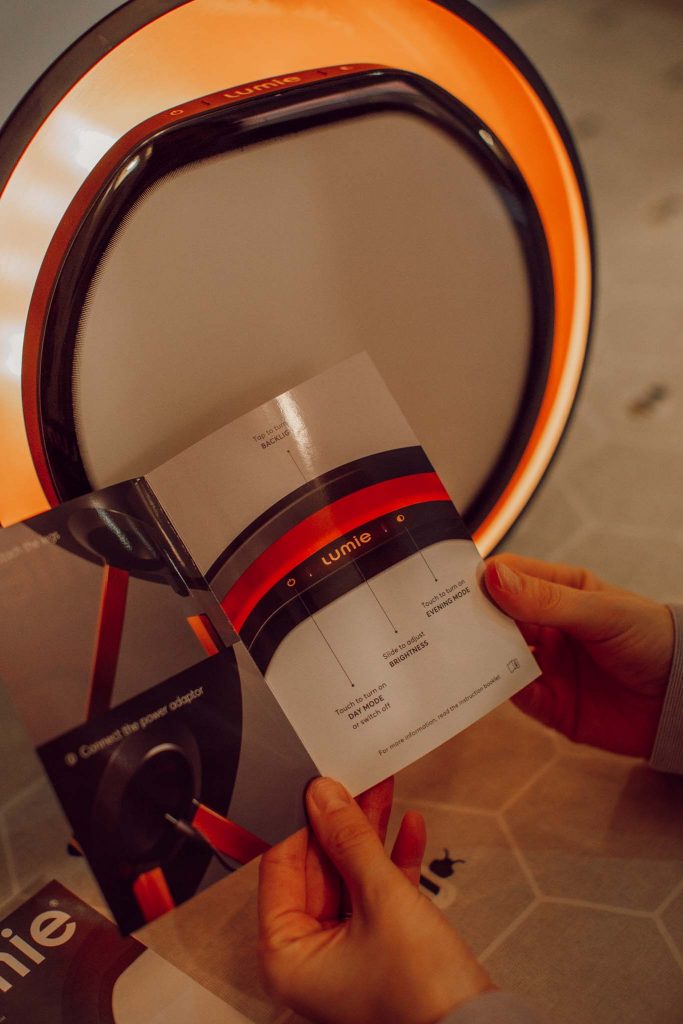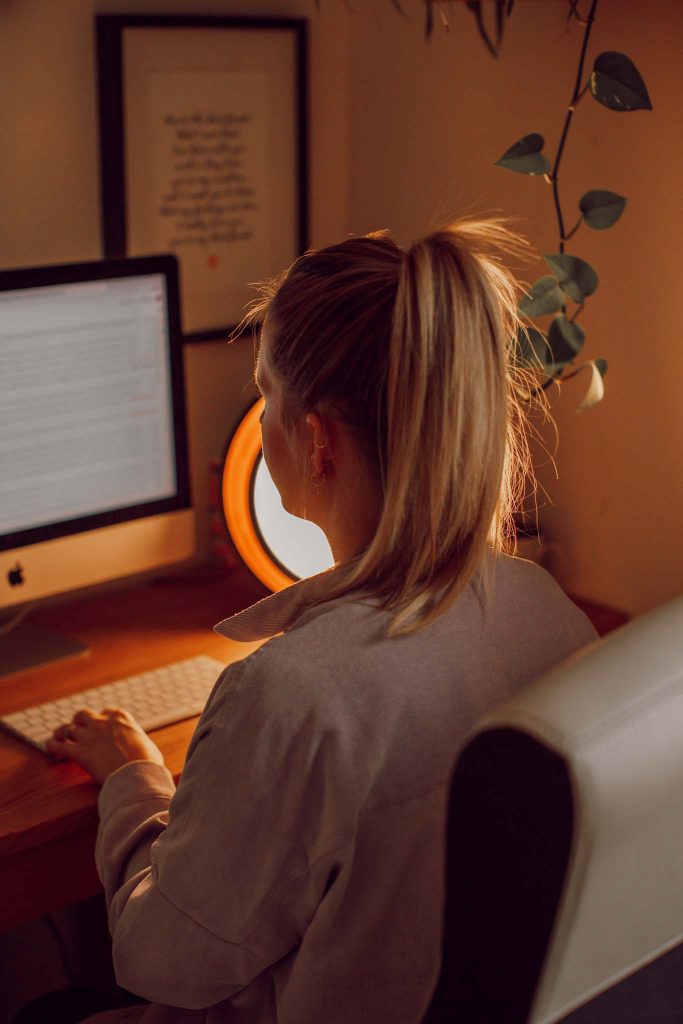In 2020, I waited for the release of the brand new Lumie Halo Light Therapy Lamp with nervous anticipation. As one of those unfortunate souls who suffers from low mood when the transition from summer to autumn begins, a light therapy light – or SAD lamp – was something I’d wanted to invest in for years.
Having travelled almost continually over the last six years, I’ve usually been lucky enough to enjoy some light therapy in its most natural form: on a sandy beach somewhere, with plenty of sunshine (and a cocktail or two).
In fact, for the last few years, I’ve made it my mission to chase the sun each time the ‘dark season’ rolled around. By jumping on a plane to Florida or the Caribbean at just the slightest hint of a gloomy winter’s night, I’d managed to keep the black cloud of SAD (Seasonal Affective Disorder) at bay.
Until, of course, a global pandemic and motherhood hit.
Stuck in lockdown and pregnant, I panicked about how I’d manage the inevitable winter blues without my usual sunshine-filled escapes. My panic resulted in a frantic search for the best SAD lamps on the market.
During this research, I thankfully stumbled across the new kid on the ‘SAD lamp’ block: the Lumie Halo. With a slick design, this gadget looked less like a SAD lamp and more like an art-deco light that you might find in a swanky boutique.
Despite its hefty price tag, I decided that this was an essential item to add to my ‘mental health toolkit’ and two years on, I have’t looked back. As a regular user of the Lumie Halo for two winters now, I’m genuinely delighted with this product.
What is the Lumie Halo Light Therapy Lamp?
The Lumie Halo Light is a ‘multifunctional light therapy lamp’, which can be used throughout the day to help better your mood, energy levels and general wellbeing – specifically during the winter. Designed to be a light that you can use from dawn until dusk, what attracted me most to the Lumie Halo Light was this very versatility.
As a light that I could use around the house all day, rather than just for a limited 30-minute ‘blast’, I decided that this was a product I could get my money’s worth from. I tend to use it mostly during the day at my desk, in its ‘day mode’, before moving it to my bedside table at night and setting it to ‘evening mode’, to help me relax.
Day Mode of Lumie Halo
The day mode feature of the Lumie Halo is essentially designed to help treat Seasonal Affective Disorder. Using warm-white and cool-white LEDs, it was a light that I initially found a bit dazzling, but soon adjusted to.
This SAD light is said to be be most effective in the morning, so I try to use it most between from 9am-11am.
How to Use the Lumie Halo in Day Mode
In order to reap the full benefit of the light, you should position the lamp at arm’s length (about 50cm from you) with the bright yellow light shining directly onto your face.
The instructions suggest that you should initially begin with 30 minutes at maximum light intensity, before increasing the duration if you feel you need more. The closer you are to the light (although I found 50cm already felt very close), the less time you’ll need in front of it.
Although you don’t need to gaze non-stop at the light (farewell, retinas), you need to make sure the light is reaching your eyes. For this reason, I find the lamp easiest to use at my desk while I’m working.
As the full beam day mode is a very bright light, there’s also a handy ‘touch and slide’ function to reduce the brightness. I use this after I feel I’ve got my fix of bright light for the day, but still want to continue enjoying the day mode for a bit longer.
Note: In this review of the best SAD lamp for 2022, I did want to touch upon the fact that I was initially delivered a product that seemed to be a little faulty in terms of the touch slider and buttons. Although disappointing, I cannot fault Lumie customer services team, who sent me a brand new (and much better functioning) light within 24 hours.
Evening Mode of Lumie Halo
After a day of bright white light, users then have the option of moving to the SAD lamp’s evening mode. This is a much softer light that creates a lovely evening glow (the sort you’d usually experience at sunset). This is described as a ‘non-alerting’ light, which means you can use it at nighttime without risking your brain being too stimulated.
During the dark nights, I find the warm glow a lovely addition to the lighting already in my home. In fact, it’s an excellent tool to help you unwind at night, reminding you to move away from your bright phone screen and begin to clock off for the day.
The Backlight
The final feature of the Lumie Halo, which is lacking on the other Lumie SAD lamps, is its backlight feature. This is a lovely ringed, orange light that adds an extra feeling of warmth to the room and makes it a stylish SAD lamp. Although this feature doesn’t have any benefits from a SAD point of view, I find the backlight makes the Lumie Halo more useable as a general light; providing a warming aesthetic around the home.


What is SAD? How Do SAD Lamps Work?
A SAD lamp is designed to be a substitute for natural sunlight, which us citizens of colder climates severely lack during the winter months.
Sunlight helps us to maintain melatonin production and serotonin (the happy hormone) levels within our bodies, leading to better mood and general wellbeing.
Without sunlight during the gloomy depths of winter, we can struggle to maintain a healthy balance of melatonin and serotonin. This can lead to low mood and Seasonal Affective Disorder, which is classed as a form of depression.
For me, Seasonal Affective Disorder usually appears towards the end of September, when my body senses a shift in seasons. I describe it as a black cloud, or winter blues, that comes and sits heavy on my brain for 4-6 weeks at a time. It’s a nagging sense of sadness, even though there’s nothing to be sad or down about.
A SAD lamp works to help replace some of the natural light that we lose during winter. Creating a bright light for use indoors, a light therapy lamp replicates the natural bright daylight we miss in winter and therefore helps to boost our mood, enhance our focus and provide a feeling of wellbeing.
Note: Light therapy lamps cannot replace the Vitamin D found in natural sunlight – so it’s important to continue taking your supplements during winter.


How Frequently Should You Use a SAD Lamp?
You should be using the Lumie Halo every day in day mode in order to really feel the benefits.
I was initially worried about remembering to get my ‘light fix’, but as I work from home, it’s felt natural to pop it on the desk and switch it on each morning. In fact, the Lumie Halo has now replaced my normal desk lamp.
How Close Should You Sit Next to a SAD Lamp?
As mentioned above, the advice by Lumie is to position the light around 50cm from you and to initially begin with 30 minutes exposure a day. If you find this isn’t enough, you can move to 60-120 minutes of bright light a day – although no ‘maximum’ time allowance is suggested.
Alternatively, if you’re happy to have the light closer, Lumie suggest 30-60 minutes if the light is positioned 32cm from you, or just 30 minutes if positioned 20cm from you.
In terms of being able to get on with other things while giving your brain a little boost, I think 50cm is easiest. I can’t imagine at 20cm you could do a lot more other than stare transfixed into the light (and Zoom calls might be a little awkward).

How is the Lumie SAD Lamp Different?
One of the most common questions I’ve received since purchasing the Lumie Halo is how it differs from Lumie’s range of wake-up lights or alarm clock.
The biggest difference between the two is that although the Lumie alarm clocks are designed with gentle light (to better start or end your day), they’re not SAD lights. Instead, they are intended to wake you up more naturally during the winter with an artificial sunrise. Due to this, the light emitted is not the same as the bright white light needed to help combat SAD.
If you’re looking for a light to boost your mood, I would therefore definitely opt for a SAD lamp, rather than a Lumie alarm clock.
Is the Lumie Halo a Portable SAD Lamp?
In short, yes.
The Lumie Halo SAD Lamp is incredibly easy to set up, featuring just a main base, two legs and a power cord. Even at nine months pregnant, I found it easy to pick up and move around the house with ease. I’ve also had no issue moving it between my desk and bedside table each night, and would say it’s the perfect compact SAD Lamp.
Does the Lumie SAD Lamp Really Improve Your Mood?
And now for the answer you’ve been waiting for (and the million-dollar question): has this SAD lamp actually improved my mood?
Having now used my SAD lamp for two weeks – weeks that have been marked by endlessly bleak, rainy days – I’m adamant that the Lumie lamp has helped my mood and energy levels. Being able to switch the light on during dark mornings has undoubtedly boosted my mood, and I’ve felt more energised and focused as a result.
Of course, I’m sure that not all of my good mood is down solely to the light – exercise, fresh air and time to unwind in the evening have been additional important factors in my serotonin levels. But I do, (genuinely), feel that it has helped me hugely.

Is the Lumie Halo Light Worth the Money?
At £169.99, the Lumie Halo is certainly an investment and not something you want to be purchasing unless you’re sure you’ll get full use from it.
I do believe that this is a SAD light that can slot into your everyday life, alongside it providing you with truly beneficial light therapy. More than just a SAD lamp, the Lumie Halo can bring a warm glow to your kitchen or lounge in the evening, and provides a lovely, calming light before bed.
Now a vital part of my mental health toolkit to see me through the winter, I genuinely look forward to using the Lumie Halo, even two years on. Brightening up my office and helping me to feel incredibly focused, I’m more than happy with this investment.

